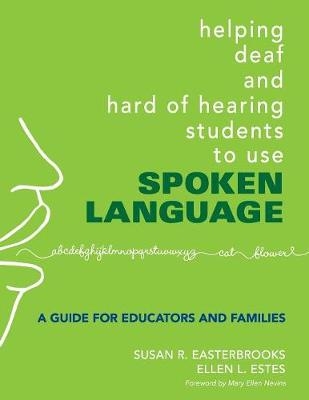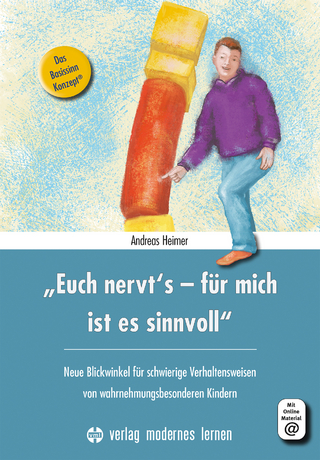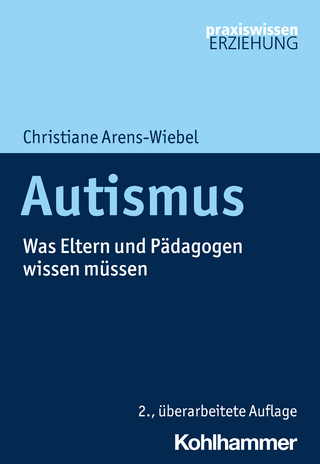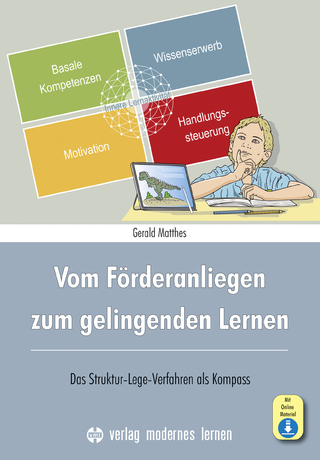
Helping Deaf and Hard of Hearing Students to Use Spoken Language
Corwin Press Inc (Verlag)
978-1-4129-2733-8 (ISBN)
"Great for parents or someone who teaches the deaf, is entering the field of audiology, or is unfamiliar with hearing loss."
—Roberta Agar-Jacobsen, Teacher of the Deaf, Tacoma Public Schools, WA
"The way the many complexities of speech are discussed, explained, and addressed is very reader-friendly, easy to understand, and accessible."
—Sherilyn Renner, Teacher of the Deaf and Hard of Hearing, Bozeman Public Schools, MT
"I have a student who is hard of hearing: How do I assist the student in speaking?"
As a result of IDEA 2004 and NCLB, more and more students with hearing loss are being educated alongside their hearing peers, making teachers and service professionals responsible for helping to fulfill their educational needs. Written by experts in the field, Helping Deaf and Hard of Hearing Students to Use Spoken Language provides educators and novice practitioners with the knowledge and skills in spoken language development to meet the needs of students who are deaf or hard of hearing.
The authors′ model of auditory, speech, and language development has been used successfully with the deaf and hard of hearing population, in training preservice teachers, and in workshops and presentations for practicing professionals. This essential resource introduces the authors′ developmental model and addresses:
Creative and scientific ways of interacting with children with hearing loss to develop spoken communication
Effective approaches, techniques, and strategies for working with children in the primary grades
Techniques for imparting social and academic information while children are learning to communicate
This authoritative reference gives teachers the confidence to provide students with a well-prepared, intensely stimulating environment to foster the natural emergence of spoken language.
Dr. Susan R. Easterbrooks is a Professor of Deaf Education in the Educational Psychology Department in the College of Education at Georgia State University and has been active in the field of deaf education for over 30 years. Dr. Easterbrooks has been a teacher, clinician, administrator, school psychologist, lecturer, and consultant and has authored numerous articles, chapters, and books on the education of children who are deaf and hard of hearing. She has participated actively on various local, state, and national committees. She currently serves as chair of the committee revising Knowledge and Skills Needed by Teachers of the Deaf and Hard of Hearing for the Division for Communicative Disabilities and Deafness of the Council for Exceptional Children. She participated in the development and revision of guidelines for services to students with hearing loss, published by the National Association of State Directors of Special Education and on the Special Needs committee of the National Board for Professional Teaching Standards. Dr. Easterbrooks resides in Gainesville, Georgia with her husband and son. Ellen L. Estes is the Coordinator of the Katherine Hamm Center, an auditory-oral program for children with hearing losses at the Atlanta Speech School (www.atlantaspeechschool.org). She has taught children with hearing losses for 30 years. She is a past-Chair of the International Professional Section of the Alexander Graham Bell Association for the Deaf and Hard of Hearing. She has written articles, conducted workshops, and advised schools throughout the country on many aspects of the language and literacy development of children who are deaf or hard of hearing. She resides in Powder Springs, Georgia with her children and two very bad dogs.
Foreword (by Mary Ellen Nevins, EdD)
Preface
Acknowledgements
About the Authors
Part 1: The Art of Intervention
1. Listening and Spoken Language Interventions: A Model and Activities for Helping Children
Listening Challenges That Children Must Overcome
Model of Auditory, Speech, and Language Development
Summary
2. Early Detection and Intervention for Infants and Toddlers
Early Detection and Intervention
Necessary Services for Infants, Toddlers, and Their Families
How Listening Develops in Infants and Toddlers
How Infants Develop Spoken Language
How Toddlers Develop Spoken Language
Interventions for Babies
Applying the Model With Babies
Interventions for Toddlers
Applying the Model With Toddlers
If a Child Is Not Making Measurable Progress
The Need for Flexible Models
Summary
3. Intervention for Preschoolers
Collaborating With Service Providers
What You Need to Know About a Child′s Hearing Loss
What You Need to Know About Previous Intervention
What You Need to Know About Listening Technology
What You Need to Know About a Child With No Prior Services
Planning and Implementing Instruction and Interventions
Factors to Consider When Planning Lessons
Techniques to Use When Conducting a Lesson
Interventions for Preschoolers
Applying the Model With Preschoolers
Summary
4. Interventions for Children in the Primary Grades
A Typical Day in the Life of the Young Student With a Hearing Loss
The Effects of Hearing Loss in the Classroom
Assessing a Child′s Present Levels of Performance
The Multidisciplinary Team of Professionals Who Can Assist the Teacher
Readiness for School
Instructional Considerations
Interventions for Children in the Primary Grades
Applying the Model With Kindergartners and Early Elementary Children
Summary
5. Developing Literacy Skills in Children With Hearing Losses
Learning to Read
Effective Approaches to Reading
Using Reading to Develop Language - A Paradox
Assessment
Implications for the Special Education Teacher
Implications for the General Education Teacher
Intervention
The Literacy Team
Summary
Part 2: The Science of Intervention
6. How Children Hear and Talk: Fundamentals of Listening and Speaking
The Speech Chain
Linguistic Level
Physiological Level: The Physiology of Speech
Physiological Level: The Physiology of Hearing
Acoustic Level
Hearing Aids, Cochlear Implants, and Assistive Listening Devices
Classroom Acoustics - Increasing the Child′s Ability to Hear and Understand the Teacher and Peers
Daily Device Monitoring: Your Responsibility
How to Give the Ling Sound Check
Summary
Resource A: Organizations and Agencies Serving Children With Hearing Losses
Resource B: Assessments
Resource C: Sound-Object Associations (by Ellen A. Rhoades, EdS)
Resource D: Commercially Available Curriculum Guides and Materials
References
Index
| Erscheint lt. Verlag | 24.7.2007 |
|---|---|
| Verlagsort | Thousand Oaks |
| Sprache | englisch |
| Maße | 215 x 279 mm |
| Gewicht | 590 g |
| Themenwelt | Schulbuch / Wörterbuch |
| Sozialwissenschaften ► Pädagogik ► Sonder-, Heil- und Förderpädagogik | |
| ISBN-10 | 1-4129-2733-1 / 1412927331 |
| ISBN-13 | 978-1-4129-2733-8 / 9781412927338 |
| Zustand | Neuware |
| Haben Sie eine Frage zum Produkt? |
aus dem Bereich


